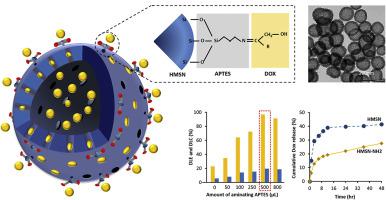Microporous and Mesoporous Materials ( IF 4.8 ) Pub Date : 2020-08-11 , DOI: 10.1016/j.micromeso.2020.110543 Thi Ngoc Tram Nguyen , Ngoc Thuy Trang Le , Ngoc Hoi Nguyen , Bui Thi Kim Ly , Trinh Duy Nguyen , Dai Hai Nguyen

|
Mesoporous silica nanoparticles (MSN) have been known as potential delivery system for doxorubicin (DOX). However, they have restricted applications due to their uncontrolled leakage, burst release of open pores and limited loading content of non-hollow core. In this study, a simple and effective system based on hollow MSN (HMSN) was synthesized and amino functionalized in order to optimize loading capacity and improve release profile for DOX delivery. HMSN were prepared following sSiO2 hard template preparation, mesoporous silica layer coating, and core template etching. Then the nanoparticles were aminated by (3-aminopropyl)-triethoxysilane (APTES) at different concentrations. Successful amino functionalization was shown by FT-IR, XPS and TGA. Surface area was revealed by BET and surface charge was determined by Zeta potential. TEM images showed high uniformity of spheres with hollow core-mesoporous shell structure and 154.0 ± 0.9 nm diameter of the aminated HMSN (HMSN-NH2), whilst the optimal –NH2 amount on the aminated HMSN surface was found to be 80.17 μg/100 mg by Kaiser test. After being aminated, HMSN-NH2 performed 3.63-fold increase in DOX loading content and 1.50-fold decrease in cumulative DOX release after 48 h. Additionally, MTT assays indicated that HMSN-NH2 was a biocompatible nanocarrier which had no toxicity on human hepatocellular carcinoma J5 (HCC J5) cells. The results suggested that the synthesized HMSN-NH2 could be a great potential nanocarrier in cancer therapy with optimal loading content and sustained release of DOX.
中文翻译:

胺化中空介孔二氧化硅纳米粒子作为阿霉素递送的增强负载和持续释放载体
中孔二氧化硅纳米粒子(MSN)已被称为阿霉素(DOX)的潜在递送系统。但是,由于其不受控制的泄漏,开孔的爆裂释放以及非空心岩心的负载量有限,它们的应用受到限制。在这项研究中,基于空心MSN(HMSN)的简单有效的系统被合成并进行氨基官能化,以优化负载能力并改善DOX释放的释放曲线。按照sSiO 2制备HMSN硬模板制备,中孔二氧化硅层涂层和核心模板蚀刻。然后,将纳米颗粒用不同浓度的(3-氨基丙基)-三乙氧基硅烷(APTES)进行胺化。FT-IR,XPS和TGA显示成功的氨基官能化。通过BET显示表面积,通过Zeta电位确定表面电荷。TEM图像显示空心中壳结构球体的高度均匀性,胺化HMSN(HMSN-NH 2)的直径为154.0±0.9 nm ,而胺化HMSN表面的最佳–NH 2量为80.17μg/通过Kaiser测试100毫克。胺化后,HMSN-NH 248小时后,DOX负载量增加了3.63倍,累积DOX释放量减少了1.50倍。此外,MTT分析表明HMSN-NH 2是一种生物相容性纳米载体,对人肝细胞癌J5(HCC J5)细胞无毒性。结果表明,合成的HMSN-NH 2具有最佳的载药量和DOX的持续释放能力,有望成为一种具有潜在治疗意义的纳米载体。











































 京公网安备 11010802027423号
京公网安备 11010802027423号